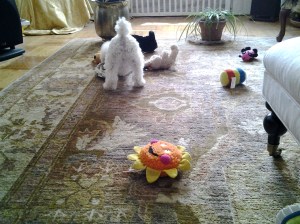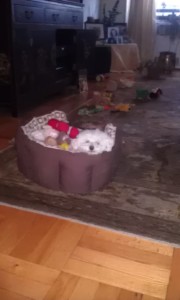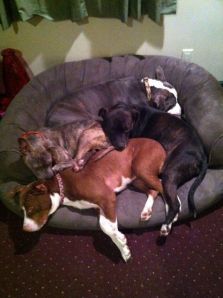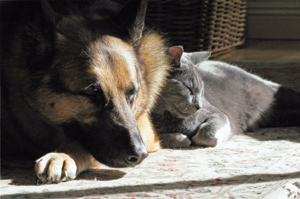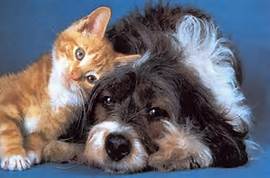
Yes, all dogs are good dogs (cats too, of course), which is what came to mind the other day when Sophie did her business right where she was supposed to, versus my rug or my bed (What a relief, those days are over). I repeated to her over and over, “Good Girl, Good Girl” in my usual high pitched voice gently clapping my hands and jumping for joy like a good little girl myself. And indeed, Sophie really has come a long way to doing all the things I set out to want her do. But the thought hit me right then, “yes she’s a good dog”, but “All Dogs are Good Dogs”. So I’ll say it again as I said it to myself, all dogs are good dogs even when they do something we prefer that they don’t. And I’ll add, “There are NO bad dogs”!
What we do have are poor training techniques, and poor behaviors ourselves. Now, I have mentioned before that I prefer conditioning and reconditioning versus training our best friends because too many times I witness people using “no” too often and especially too harshly when “training their dogs”. I personally have only used the word no two or three times in 8 months, and it isn’t because Sophie came home with me behaving perfectly (Don’t want a perfect dog anyway).
Now I am not an animal behaviorist so please know that I am not writing as a professional here, but the training methods including “corrections” are just not in my repertoire. Yet, I can say that positive reconditioning and reinforcement techniques are and have worked for me, while I have witnessed people correcting their dogs over and over for the same behavior that they want changed.
Here’s just one example.
My neighbor tugs and jerks her little dog’s collar every single time he barks quite ferociously as a bigger dog is coming down the block. Her dog starts barking when the bigger dog is about ¼ of a block away and continues while lunging as the dog passes. Yet, each time that she jerks his collar calling him a bad boy, he continues. Good dog, poor reconditioning. Some people may call it poor training, but I hope we can “recondition” ourselves to never say bad dog.
While I did touch upon animal behavior in school, I learned more about some wonderful conditioning tips from a book titled “For the Love of a Dog” by Patricia McConnell. What I did do with my little Sophie was to reward the positive behaviors and ignore the not so positive behaviors. The rewards were and are anything from me lightly squealing in a high pitch voice repeating good girl jumping and clapping with big smiles, to giving her little pieces of chicken. And boy did she catch on fast. While all dogs have individual personalities with individual temperaments generally they want to please us, and getting a favorite treat doesn’t hurt either!
You might ask, but how does that prevent the not so good behaviors? That is where part of the reconditioning comes into play. If we can catch the behaviors beforehand, we can distract and reward another behavior that is positive immediately. So if we have our dog turn away and sit at the first sign of another dog approaching before he barks, rewarding him, then over time this reconditions the behavior we want. The point is to gradually reward the positive behavior as an approaching dog gets closer and closer until he realizes that he will be rewarded for not barking and lunging. Of course, I’ve really simplified this. Let me say that along the way, I developed more patience, a more positive behavior myself as well.
Adopting Sophie has been much more rewarding than I ever expected. I had my own expectations and quite a few surprises from Sophie about her many behaviors, which now are well on their way to being all positive. One, which I mention in my first post, would have been a deal breaker 20 years ago.
Behavioral problems are one of the top reasons people bring their dogs to shelters, and bring back their adopted dogs to a shelter. Is it a dog’s fault? Is the dog bad? Absolutely not. One major problem is a lack of positive conditioning, knowledge, patience and commitment.
Of course there are other reasons people give up their dogs and cats, including not choosing the right species, breed, personality, etc. when they pick a new dog or cat. I know that 20 years ago I chose a wonderful dog but the one wrong for me and my lifestyle. Good dog, wrong decision on my part. All Dogs are Good Dogs. So while some reality shows have titles such as Bad Dog, or The Cat from Hell, these titles are meant to grab our attention. Bad Dog shows the mischievous ways our friends can behave, while doing so in a humorous way, and The Cat from Hell I am pleased to say addresses what behaviors we humans need to change versus blaming the cat. I can only hope that we change our perceptions and behaviors so that we don’t need to name these shows with sensationalized titles reinforcing how we use animals in a negative way in our everyday language (He treated me like a dog, for instance).Maybe then we can contribute to less good dogs and cats becoming homeless.
Adopt and Save a Life.
Next: What studies suggest about selecting a best friend!

